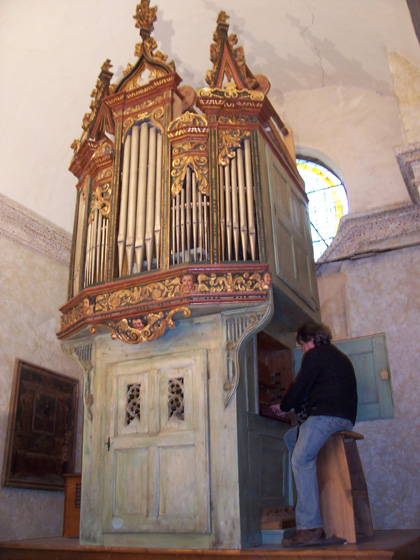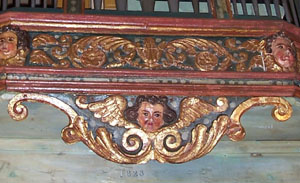

Organ : 2 keyboards , pedalboard - 9 stops

The history of this organ is directly connected to that of the organ on the swallow's nest in the cathedral's main nave. The chapel sainte-Anne is an ancient church attached to the cathedral. We reach it by the inside of this one and by a door which, when it's closed, isolates completely the chapel from the building. This chapel contains the "treasure" of the cathedral, that is an important collection of ancient ecclesiastical ornaments, decorated with magnificent polychromatic embroideries, and a set of paintings of the 14th century and other diverse periods.
The organ is situated on a gallery in the bottom of the small nave. We built an additional level on this gallery in a way that the sight of the case since the nave is more readable. This case is partially constituted by the ancient choir organ, built by the brothers Eustache, and put in 1635 in front of the organ's Gothic case on its swallow's nest. The superior ornaments also come from this case just like the corner pieces on the sides of the lower cases (see the study of reconstruction of the Gothic case).
Composition :
| 1er clavier - 49 notes | 2ème clavier - 49 notes | Pédale - 22 notes |
| Bourdon 8' | Bourdon 8' | Bourdon 8' |
| Montre 4' | Flûte 4' | |
| Doublette 2' | Cornet 4 rangs | |
| Plein-Jeu 3 rangs | Cromorne |
Pedalcoupler : 2th keyboard, Tremulant
This reorganization is due to Samson Scherrer (1750). Samson Scherrer also took the windchests of 6 stops of the positive which he divided into two sections so creating two sound divisions. He also used keyboards still remaining at that time i n the organ of the cathedral.
n the organ of the cathedral.
These very beautiful bone plated keyboards, key fronts of which are trilobed, are fitted in "arms" in shape of wooden volutes of ebony. A small French-style pedalboard of 13 pedal-keys completes this whole arrangement, heterogenous but however very coherent.
Two cuneiform bellows of 6 feet X 2 feet are placed on the organ's roof. A system of pulleys and ropes allows to activate them. These two bellows reached us in an intact state from their origin, so that it was not necessary to change the leather during its restoration.
Few pipes remained, found scattered in the lower case during the dismounting: some pipes of Bourdon and Flute 4' of small size, the entire basses of wooden Bourdon and the pipes of facade among which those of tin, come very probably from the facade still in position before 1750 in the cathedral's Gothic case. The rack boards, well preserved as the windchest, gave the indications for the establishment of the sizes of the pipework which it was necessary to reconstruct.
The composition of this instrument allows to approach many 17th and 18th French repertoire, in good conditions. The tone is 392 hz in 18 ° and the temperament was made according to a meantone temperament with 8 pure thirds.